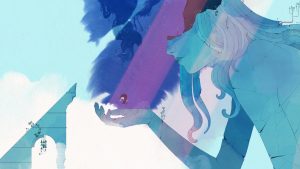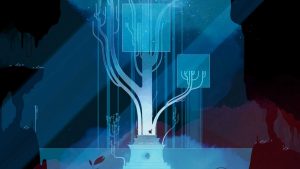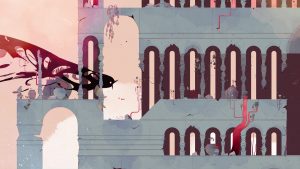Gris begins with a young girl cradled in the hand of a statue of a woman. The girl sings a few ethereal notes, but her voice breaks and the statue starts to crack. She tries to sing again, desperately attempting to keep the statue together with the sound of her voice, but eventually she chokes, falls silent, and the stone woman crumbles into pieces. The young girl falls from a great height and lands in a lonely, empty, grey landscape below.

Gris is a wordless videogame. There is no dialogue, no voice over, no written text – just the gentle bleed of ink and watercolours, a set of simple movement mechanics, and a musical soundtrack that alternates between sparse, brittle piano notes and a smooth, symphonic chorus of strings and electronic instruments. The visual, haptic, and audio layers combine to create a non-verbal language to describe bereavement.
The game is scaffolded by the Kübler-Ross model of grief, which describes five stages of denial, anger, bargaining, depression, and acceptance. However, in many ways, Gris is about the limits of these labels, and the impossibility of distilling or arranging the experience of loss into a coherent description. The game’s exposition strips the avatar of her ability to sing, leaving her voiceless and clutching at her throat as her world collapses around her, suggesting she has lost the ability to communicate. The player accompanies the newly silent girl as she traverses a wordless world, sensing what she is feeling through colours, movements, and melodies.
The player and the girl travel across voids, deserts, oceans, and a night’s sky, interacting with fantastical versions of butterflies, eels, swallows, fireflies, a giant blackbird, and a majestic turtle along the way. Grief is represented as a journey, where the movement through space works as a metaphor for the passage of time. However, Gris troubles the linearity inscribed in the Kübler-Ross schema. Unlike most platform games where players are pressed inexorably from left to right, in Gris they are continually moving up and down along the y-axis, making the spatial metaphor of ‘experiencing highs and lows’ concrete. During the ‘depression’ phase, for example, the girl plummets downwards, diving deep into underground caverns that function both as places of refuge and as labyrinthine traps. Depression is not represents as something that can be moved past – it is an axis of feeling that is always there. Furthermore, the levels require players to constantly loop back on themselves, implying that the girl is moving through the same locations over and over again, just at different points in time. This disrupts the idea of grieving as a unidirectional process with an end-goal to attain.
At first, the game’s environments are hushed, grey, and desolate, but as players progress through the levels, colour slowly returns to the world. Reds, blues, greens, and yellows seep and blend into each other, and the interplay of light and shadow, water ripples, and leaf shivers, make the world feel increasingly alive. A recurrent visual motif in the game is trees as neurons as circuit boards, so that the natural, the neurological, and the computational seem to stand in for each other, and players are left wondering whether they are moving through a fantasy landscape, a mindscape, or a web of code – the inner workings of the game itself laid bare for reprogramming.

The monochromatic colour schemes of early levels evoke the experience of viewing the world through the lens of different mental states. The early grey wreckages and ruins represent a kind of numbness that is gradually coloured with feeling, but the additive effect of layering colours on top of each other challenges the ‘recovery’ narrative of grieving. The red of anger is never really left behind; rather it is blended with green of bargaining, giving it a softer glow, and accented by the blue of depression, creating deep, bruising purples.
The one colour that lacks this translucent, hand-painted quality is the thick, oozing, lightless black acrylic that almost overcomes the whole screen at several points during the game. The dense black colour cannot be blended or painted over: it is consuming, erasing, and absolutely final. The panic and claustrophobia elicited by the colour black draws attention to the synaesthetic effect of all the game’s colours, which are not only seen but felt.
Just as the audiovisual dimension of the game doesn’t simplify the grieving experience, the mechanical dimension is also complex. Floating and falling are the game’s main mechanics, and they capture a sense of inescapable gravity and also dissociative weightlessness: being weighed down and being untethered are two embodied vertiginous feelings associated with grief. The girl later learns how to fly with the assistance of murmurations of swallows, and how to turn her cloak into a hefty, solid cube that can withstand gale-force winds. Sensations that had previously been out of the girl’s control become forces that players can influence, which gives them an increased feeling of mastery over grief.

The cube-move is awkward and ungainly, and it looks a little bit like the girl is throwing a tantrum. This move also demands a lot of patience, as the player must sit and wait with the girl ‘cubed’ until the wind has died down and they can progress again. Because this mechanic is first encountered in the red level – and because it can be used to smash vases and weakened rocks – ‘cubing’ is associated with anger. However, the fact that in addition to being a destructive gesture it also a defiant gesture – one that equips players with the stubborn resolve to withstand a force that would otherwise push them back to their starting position – nuances the role of anger in grieving.
Similarly, the ludic obstacle presented by the huge blackbird that chases and stalks players around the levels seems to symbolise self-doubt, or even self-loathing. It is an internal hurdle that is externalised as a vicious, screaming bird, whose screech actually pushes the girl off of platforms. However, it soon becomes impossible to progress through the level without using this awful bird to make the leap between certain places: its propulsive scream gives the girl the momentum she needs to carry on. The message inscribed in the rules here is that your pain is not always and not only your enemy. You must find ways to co-exist with it so that it doesn’t push you off of high platforms, but so that it carries you forward, as risky as that leap might be.

Gris shows that grief cannot be neatly captured in stages or in words – it is a convoluted, confusing blurring of sensations and thoughts. In the final level, all of the colours and mechanics previously learned are integrated, allowing players to puzzle their way through a celestial city in the sky. Mechanics associated with anger, denial, bargaining, and depression become tools – coping strategies – for navigating the world. The environment is still full of challenges, but it is beautiful, and the girl’s passage through it is graceful and balletic. Her voice slowly returns, and when she sings to the night sky lines connect stars to form constellations. The visual metaphor is one that implies grieving is more than the sum of its constituent parts.
This game’s reluctance to put bereavement into words carves out a subjective space for players to articulate their own experiences of grief. For this reason, Gris could be a valuable prompt and process for those struggling to express the emotions and feel heard. The game is available to purchase here and is available on PC, Playstation, and Nintendo Switch.
Posted: